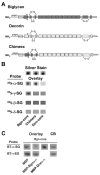Biglycan binds to alpha- and gamma-sarcoglycan and regulates their expression during development
- PMID: 16883602
- PMCID: PMC2929672
- DOI: 10.1002/jcp.20740
Biglycan binds to alpha- and gamma-sarcoglycan and regulates their expression during development
Abstract
The dystrophin-associated protein complex (DAPC), which links the cytoskeleton to the extracellular matrix, is essential for muscle cell survival, and is defective in a wide range of muscular dystrophies. The DAPC contains two transmembrane subcomplexes-the dystroglycans and the sarcoglycans. Although several extracellular binding partners have been identified for the dystroglycans, none have been described for the sarcoglycan subcomplex. Here we show that the small leucine-rich repeat (LRR) proteoglycan biglycan binds to alpha- and gamma-sarcoglycan as judged by ligand blot overlay and co-immunoprecipitation assays. Our studies with biglycan-decorin chimeras show that alpha- and gamma-sarcoglycan bind to distinct sites on the polypeptide core of biglycan. Both biglycan proteoglycan as well as biglycan polypeptide lacking glycosaminoglycan (GAG) side chains are components of the dystrophin glycoprotein complex isolated from adult skeletal muscle membranes. Finally, our immunohistochemical and biochemical studies with biglycan null mice show that the expression of alpha- and gamma-sarcoglycan is selectively reduced in muscle from young (P14-P21) animals, while levels in adult muscle (> or = P35) are unchanged. We conclude that biglycan is a ligand for two members of the sarcoglycan complex and regulates their expression at discrete developmental ages.
Copyright 2006 Wiley-Liss, Inc.
Figures





Similar articles
-
The small leucine-rich repeat proteoglycan biglycan binds to alpha-dystroglycan and is upregulated in dystrophic muscle.J Cell Biol. 2000 Feb 21;148(4):801-10. doi: 10.1083/jcb.148.4.801. J Cell Biol. 2000. PMID: 10684260 Free PMC article.
-
Decorin and biglycan expression is differentially altered in several muscular dystrophies.Brain. 2005 Nov;128(Pt 11):2546-55. doi: 10.1093/brain/awh635. Epub 2005 Sep 23. Brain. 2005. PMID: 16183658
-
The sarcoglycan complex in skeletal muscle.Front Biosci (Landmark Ed). 2016 Jan 1;21(4):744-56. doi: 10.2741/4418. Front Biosci (Landmark Ed). 2016. PMID: 26709803 Review.
-
Sarcoglycan complex: implications for metabolic defects in muscular dystrophies.J Biol Chem. 2009 Jul 17;284(29):19178-82. doi: 10.1074/jbc.C109.010728. Epub 2009 Jun 3. J Biol Chem. 2009. PMID: 19494113 Free PMC article.
-
Sarcoglycans in muscular dystrophy.Microsc Res Tech. 2000 Feb 1-15;48(3-4):167-80. doi: 10.1002/(SICI)1097-0029(20000201/15)48:3/4<167::AID-JEMT5>3.0.CO;2-T. Microsc Res Tech. 2000. PMID: 10679964 Review.
Cited by
-
Extracellular matrix: Brick and mortar in the skeletal muscle stem cell niche.Front Cell Dev Biol. 2022 Nov 29;10:1056523. doi: 10.3389/fcell.2022.1056523. eCollection 2022. Front Cell Dev Biol. 2022. PMID: 36523505 Free PMC article. Review.
-
Sarcoglycanopathies: molecular pathogenesis and therapeutic prospects.Expert Rev Mol Med. 2009 Sep 28;11:e28. doi: 10.1017/S1462399409001203. Expert Rev Mol Med. 2009. PMID: 19781108 Free PMC article. Review.
-
Characterisation of Progressive Skeletal Muscle Fibrosis in the Mdx Mouse Model of Duchenne Muscular Dystrophy: An In Vivo and In Vitro Study.Int J Mol Sci. 2022 Aug 5;23(15):8735. doi: 10.3390/ijms23158735. Int J Mol Sci. 2022. PMID: 35955872 Free PMC article.
-
The collagen VI-related myopathies: muscle meets its matrix.Nat Rev Neurol. 2011 Jun 21;7(7):379-90. doi: 10.1038/nrneurol.2011.81. Nat Rev Neurol. 2011. PMID: 21691338 Free PMC article. Review.
-
LDL particle core enrichment in cholesteryl oleate increases proteoglycan binding and promotes atherosclerosis.J Lipid Res. 2013 Sep;54(9):2495-503. doi: 10.1194/jlr.M039644. Epub 2013 Jun 26. J Lipid Res. 2013. PMID: 23804810 Free PMC article.
References
-
- Adams ME, Butler MH, Dwyer TM, Peters MF, Murnane AA, Froehner SC. Two forms of mouse syntrophin, a 58 kd dystrophin-associated protein, differ in primary structure and tissue distribution. Neuron. 1993;11(3):531–540. - PubMed
-
- Ahn AH, Freener CA, Gussoni E, Yoshida M, Ozawa E, Kunkel LM. The three human syntrophin genes are expressed in diverse tissues, have distinct chromosomal locations, and each bind to dystrophin and its relatives. J Biol Chem. 1996;271(5):2724–2730. - PubMed
-
- Ameye L, Young MF. Mice deficient in small leucine-rich proteoglycans: novel in vivo models for osteoporosis, osteoarthritis, Ehlers-Danlos syndrome, muscular dystrophy, and corneal diseases. Glycobiology. 2002;12(9):107R–116R. - PubMed
-
- Bianco P, Fisher LW, Young MF, Termine JD, Robey PG. Expression and localization of the two small proteoglycans biglycan and decorin in developing human skeletal and non-skeletal tissues. J Histochem Cytochem. 1990;38(11):1549–1563. - PubMed
Publication types
MeSH terms
Substances
Grants and funding
LinkOut - more resources
Full Text Sources
Other Literature Sources
Research Materials
Miscellaneous

